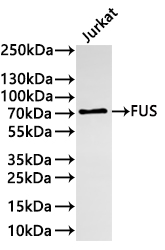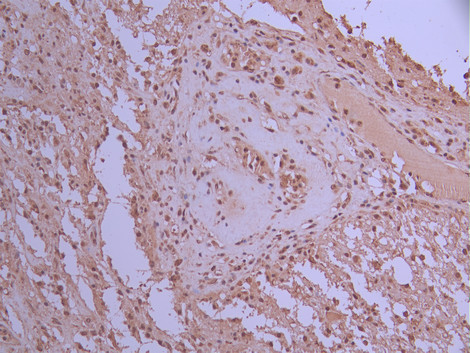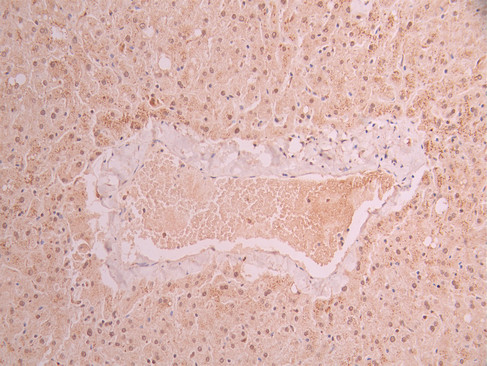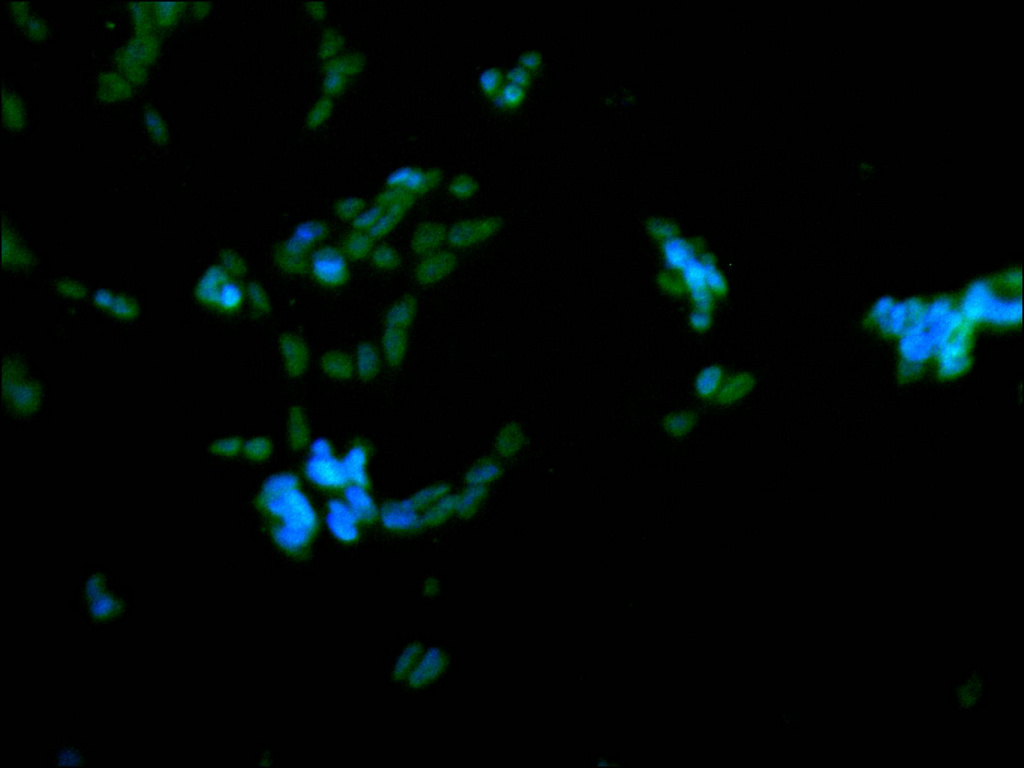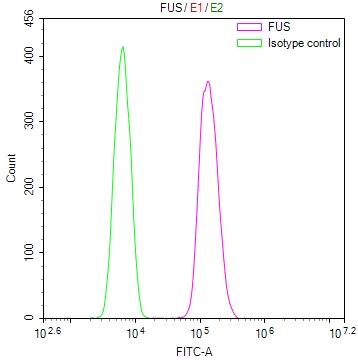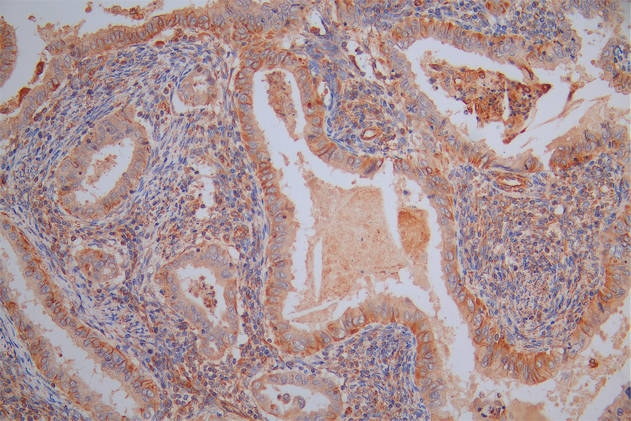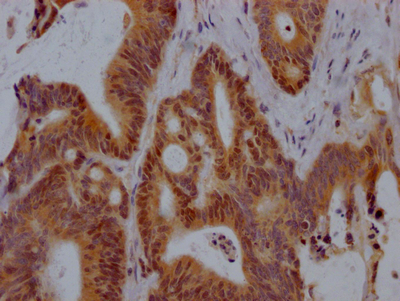FUS Recombinant Monoclonal Antibody
-
中文名稱:FUS Recombinant Monoclonal Antibody
-
貨號:CSB-RA796544A0HU
-
規格:¥1320
-
圖片:
-
Western Blot
Positive WB detected in:Jurkat whole cell lysate(30μg)
All lanes: FUS antibody at 1:1000
Secondary
Goat polyclonal to rabbit IgG at 1/40000 dilution
Predicted band size: 53 kDa
Observed band size: 70 kDa
Exposure time:2min -
IHC image of CSB-RA796544A0HU diluted at 1:100 and staining in paraffin-embedded human glioma cancer performed on a Leica BondTM system. After dewaxing and hydration, antigen retrieval was mediated by high pressure in a citrate buffer (pH 6.0). Section was blocked with 10% normal goat serum 30min at RT. Then primary antibody (1% BSA) was incubated at 4°C overnight. The primary is detected by a Goat anti-rabbit polymer IgG labeled by HRP and visualized using 0.05% DAB.
-
IHC image of CSB-RA796544A0HU diluted at 1:100 and staining in paraffin-embedded human liver tissue performed on a Leica BondTM system. After dewaxing and hydration, antigen retrieval was mediated by high pressure in a citrate buffer (pH 6.0). Section was blocked with 10% normal goat serum 30min at RT. Then primary antibody (1% BSA) was incubated at 4°C overnight. The primary is detected by a Goat anti-rabbit polymer IgG labeled by HRP and visualized using 0.05% DAB.
-
Immunofluorescence staining of SH-SY5Y cell with CSB-RA796544A0HU at 1:50, counter-stained with DAPI. The cells were fixed in 4% formaldehyde, permeabilized using 0.2% Triton X-100 and blocked in 10% normal Goat Serum. The cells were then incubated with the antibody overnight at 4°C. The secondary antibody was Alexa Fluor 488-congugated AffiniPure Goat Anti-Rabbit IgG(H+L).
-
Overlay Peak curve showing SH-SY5Y cells stained with CSB-RA796544A0HU (red line) at 1:100. The cells were fixed in 4% formaldehyde and permeated by 0.2% TritonX-100 for?10min. Then 10% normal goat serum to block non-specific protein-protein interactions followed by the antibody (1ug/1*106cells) for 45min at 4℃. The secondary antibody used was FITC-conjugated goat anti-rabbit IgG (H+L) at 1/200 dilution for 35min at 4℃.Control antibody (green line) was Rabbit IgG (1ug/1*106cells) used under the same conditions. Acquisition of >10,000 events was performed.
-
-
其他:
產品詳情
-
Uniprot No.:
-
基因名:FUS
-
別名:RNA-binding protein FUS (75 kDa DNA-pairing protein) (Oncogene FUS) (Oncogene TLS) (POMp75) (Translocated in liposarcoma protein), FUS, TLS
-
反應種屬:Human
-
免疫原:A synthesized peptide from human FUS protein
-
免疫原種屬:Homo sapiens (Human)
-
標記方式:Non-conjugated
-
克隆類型:Monoclonal
-
抗體亞型:Rabbit IgG
-
純化方式:Affinity-chromatography
-
克隆號:9E7
-
濃度:It differs from different batches. Please contact us to confirm it.
-
保存緩沖液:Preservative: 0.03% Proclin 300
Constituents: 50% Glycerol, 0.01M PBS, PH 7.4 -
產品提供形式:Liquid
-
應用范圍:ELISA, WB, IHC, IF, FC
-
推薦稀釋比:
Application Recommended Dilution WB 1:500-1:2000 IHC 1:50-1:200 IF 1:50-1:200 FC 1:50-1:200 -
Protocols:
-
儲存條件:Upon receipt, store at -20°C or -80°C. Avoid repeated freeze.
-
貨期:Basically, we can dispatch the products out in 1-3 working days after receiving your orders. Delivery time maybe differs from different purchasing way or location, please kindly consult your local distributors for specific delivery time.
-
用途:For Research Use Only. Not for use in diagnostic or therapeutic procedures.
相關產品
靶點詳情
-
功能:DNA/RNA-binding protein that plays a role in various cellular processes such as transcription regulation, RNA splicing, RNA transport, DNA repair and damage response. Binds to nascent pre-mRNAs and acts as a molecular mediator between RNA polymerase II and U1 small nuclear ribonucleoprotein thereby coupling transcription and splicing. Binds also its own pre-mRNA and autoregulates its expression; this autoregulation mechanism is mediated by non-sense-mediated decay. Plays a role in DNA repair mechanisms by promoting D-loop formation and homologous recombination during DNA double-strand break repair. In neuronal cells, plays crucial roles in dendritic spine formation and stability, RNA transport, mRNA stability and synaptic homeostasis.
-
基因功能參考文獻:
- loss of nuclear FUS caused DNA nick ligation defects in motor neurons. PMID: 30206235
- The herein presented data uncover a novel mechanism by which the fusion oncogene FUS-CHOP actively promotes invasion in myxoid and round cell liposarcoma through the activation of a SRC/FAK/RHO/ROCK signaling axis. PMID: 29190494
- When FUS was overexpressed and then de novo synthesis was blocked with ActD, the decay rate of LATS1/2 was slower in the FUS-overexpressed cells than in control cells. PMID: 30308519
- Motor neuron cultures exposed to mutant FUS (mutFUS)conditioned medium (ACM), but not wild-type FUS ACM, undergo significant cell loss, which is preceded by progressive degeneration of neurites. We found that Tumor TNFalpha is secreted into ACM of mutFUS-expressing astrocytes. Accordingly, mutFUS astrocyte-mediated motor neuron toxicity is blocked by targeting soluble TNFalpha with neutralizing antibodies. PMID: 29380416
- the abnormal stable complex of FUS-R521C/PRMT1/Nd1-L mRNA could contribute to neurodegeneration upon oxidative stress. PMID: 28094300
- more selective group of neurons appears to be affected in frontotemporal lobar degeneration (FTLD)-TDP and FTLD-FUS than in FTLD-tau PMID: 28984110
- Taken together, FUS RNA-recognition motif appears to play a crucial role in exaggerating the physiological/reversible self-assembly into pathological/irreversible fibrillization, thus contributing to manifestation of FUS cytotoxicity. PMID: 28432364
- Fus is a binding partner of FMRP. PMID: 28424484
- Study demonstrates that FUS mutants, but not WT forms, impair fast axonal transport (FAT) in brain tissue of patients with ALS, through a mechanism dependent on activation of p38 MAPK. PMID: 28273913
- In human stem cell-derived motor neurons, the RNA profile associated with concomitant loss of both TAF15 and FUS resembles that observed in the presence of the amyotrophic lateral sclerosis (ALS)-associated mutation FUS R521G, but contrasts with late-stage sporadic ALS patients. PMID: 27378374
- FUS P525L mutation alters transcriptome and microRNA pathways in motor neurons with implications for ALS pathogenesis. PMID: 28988989
- This study showed that in fibroblasts of FUS P525L mutation carriers, FUS mislocalized to the cytoplasm where it redistributed into stress granules with likely a dose effect. PMID: 29035885
- Results find that mutant but not wild-type FUS decreased dendritic growth, mRNA levels, and protein synthesis in dendrites. These data suggest that cytoplasmic FUS aggregates trap mRNA and its transporters, impairing dendritic mRNA trafficking and translation, in turn leading to the disruption of dendritic homeostasis and the development of frontotemporal dementia phenotypes. PMID: 28928015
- activation of the IGF-IR/PI3K/Akt signaling system is a common pattern in MLS which appears to be transcriptionally controlled, at least in part by induction of IGF2 gene transcription in a FUS-DDIT3-dependent manner. PMID: 28637688
- SOD1 mutations were present in 20% of familial amyotrophic lateral sclerosis (ALS) patients and 1.9% of sporadic ALS patients, while FUS mutations were responsible for 13.3% of familial ALS cases, and TARDBP mutations were rare in either familial or sporadic ALS cases. PMID: 27604643
- Depletion of SAFB1 reduced FUS's localization to chromatin-bound fraction and splicing activity, suggesting SAFB1 could tether FUS to chromatin compartment thorough N-terminal DNA-binding motif. Moreover, FUS interacts with another nuclear matrix-associated protein, Matrin3. PMID: 27731383
- A molecular docking and dynamics study concluded that R521C and R521H mutations in FUS result in weak binding with Karyopherin-beta2 leading to amyotrophic lateral sclerosis. PMID: 27381509
- both FUS and TDP43 colocalize with active RNA polymerase II at sites of DNA damage along with the DNA damage repair protein, BRCA1, and FUS and TDP43 participate in the prevention or repair of R loop-associated DNA damage, a manifestation of aberrant transcription and/or RNA processing PMID: 27849576
- FUS mutations were significantly more common among mainland Chinese patients than those among Caucasian populations (p=6.8x10-3). The high frequency of FUS mutations in FALS and SALS in mainland China is another genetic feature distinct from Caucasians. PMID: 26519472
- The impairment of PARP-dependent DNA damage response (DDR) signaling due to mutations in the FUS nuclear localization sequence induces additional cytoplasmic FUS mislocalization which in turn results in neurodegeneration and FUS aggregate formation in amyotrophic lateral sclerosis. PMID: 29362359
- ALS-associated mutations enhance FUS protein propagation in Drosophila neurons. PMID: 28429234
- juvenile ALS linked to FUS mutations represent a specific entity different from both classical juvenile ALS and adult ALS linked to FUS gene PMID: 28054830
- Motor neurons expressing FUS with the P525L or the R521H mutation showed cytoplasmic mislocalization of FUS, hypoexcitability, and axonal transport defects. PMID: 29021520
- Results suggest that RBM45 serves as a negative regulator to prevent FUS-mediated excessive recruitment of HDAC1 to the sites of DNA damage. PMID: 29140459
- The review describes the main physiological functions of FUS and considers evidence for each of the theories of amyotrophic lateral sclerosis pathogenesis. PMID: 28707655
- Authors used solid-state nuclear magnetic resonance methods to characterize the molecular structure of self-assembling fibrils formed by the LC domain of the fused in sarcoma (FUS) RNA-binding protein. From the 214-residue LC domain of FUS (FUS-LC), a segment of only 57 residues forms the fibril core, while other segments remain dynamically disordered. PMID: 28942918
- Nuclear magnetic resonance spectroscopy demonstrates the intrinsically disordered structure of FUS's nearly uncharged, aggregation-prone, yeast prion-like, low sequence-complexity domain is preserved after phosphorylation. PMID: 28790177
- Long noncoding RNA SchLAH functions through interaction with fused in sarcoma protein (FUS). PMID: 28196303
- Focus on the recent advances on approaches to uncover the mechanisms of wild type and mutant FUS proteins during development and in neurodegeneration (review). PMID: 27033831
- FUS-induced reductions to ER-mitochondria associations and are linked to activation of glycogen synthase kinase-3beta (GSK-3beta), a kinase already strongly associated with ALS/FTD. PMID: 27418313
- Motor-neuron disease (MND)-linked RNA-binding proteins (RBPs), TDP-43, FUS, and hnRNPA2B1, bind to and induce structural alteration of UGGAAexp. These RBPs suppress UGGAAexp-mediated toxicity in Drosophila by functioning as RNA chaperones for proper UGGAAexp folding and regulation of pentapeptide repeat translation. PMID: 28343865
- we analyzed fast axonal transport in larval motor neurons of Drosophila models of TARDBP (TDP-43), FUS and C9orf72. We also analyzed the effect of loss-of-function mutants of the Drosophila orthologs of TDP-43 and FUS, TBPH and caz, respectively. The motor activities of larvae and adults in these models were assessed to correlate potential defects in axonal transport with locomotor deficits PMID: 27056981
- These findings suggest a possible pathomechanism for amyotrophic lateral sclerosis in which mutated FUS inhibits correct splicing of minor introns in mRNAs encoding proteins required for motor neuron survival. PMID: 27252488
- This study revealed a characteristic phenotype in FUS/TLS-linked FALS patients in Japan. PMID: 26823199
- The aim of this review will be to provide a general overview of TDP-43 and FUS/TLS proteins and to highlight their physiological functions--{REVIEW} PMID: 27015757
- Mouse model that overexpresses FUS without a nuclear localization signal (DeltaNLS-FUS) shows progressive motor deficits/ALS phenotype PMID: 27368346
- Possible role of deregulated DNA binding function of FUS in ALS. PMID: 27693252
- Our in vivo studies of the hFUS-Q290X mutation in Drosophila link motor dysfunction to impairment in the GABAergic pathway. Our findings would facilitate further efforts in unravelling the pathophysiology of Essential tremor PMID: 27395408
- FUS is glycosylated with a high stoichiometry not only in the neural cells but also in the non-neural cell lines. PMID: 27903134
- The results of this study suggested that FUS mutations are the most frequent genetic cause in early-onset sporadic ALS patients of Chinese origin. PMID: 26972116
- Data show that induced pluripotent stem cells (iPSC)-derived motor neurons mimicked several neurodegenerative phenotypes including mis-localization of fused-in sarcoma (FUS) gene product into cytosolic. PMID: 26997647
- miR-141 and the FUS gene, which are inversely correlated, play significant functional roles in regulating human neuroblastoma. PMID: 26936280
- pathological TDP-43 and FUS may exert motor neuron pathology in amyotrophic lateral sclerosis through the initiation of propagated misfolding of SOD1 PMID: 26926802
- iNeurons may provide a more reliable model for investigating FUS mutations with disrupted NLS for understanding FUS-associated proteinopathies in amyotrophic lateral sclerosis PMID: 26795035
- A subset of juvenile-onset familial/sporadic ALS cases with FUS gene mutations reportedly demonstrates mental retardation or learning difficulty. PMID: 26984092
- Study implicates phosphorylation as an additional mechanism by which nuclear transport of FUS might be regulated and potentially perturbed in ALS and FTLD. PMID: 26403203
- Study identifies a common mechanism of transport into neurites of proteins linked to the pathology of Alzheimer's disease (i.e. sAPP) and ALS (i.e. FUS, TDP-43 and SOD1) PMID: 26605911
- RNA binding proteins TDP-43 and FUS do not consistently fit the currently characterised inclusion models suggesting that cells have a larger repertoire for generating inclusions than currently thought. PMID: 26293199
- Wild-type and mutant hFUS proteins induced neuronal degeneration with partial selectivity for motor neurons. Motor neuron loss was accompanied by abnormal neurite morphology and length. PMID: 26174443
- FUS mutation seems indicated in sporadic early-onset ALS patients especially if showing predominant bulbar symptoms and an aggressive disease course. PMID: 26362943
顯示更多
收起更多
-
相關疾病:Angiomatoid fibrous histiocytoma (AFH); Amyotrophic lateral sclerosis 6, with or without frontotemporal dementia (ALS6); Tremor, hereditary essential 4 (ETM4)
-
亞細胞定位:Nucleus.
-
蛋白家族:RRM TET family
-
組織特異性:Ubiquitous.
-
數據庫鏈接:
Most popular with customers
-
-
YWHAB Recombinant Monoclonal Antibody
Applications: ELISA, WB, IHC, IF, FC
Species Reactivity: Human, Mouse, Rat
-
Phospho-YAP1 (S127) Recombinant Monoclonal Antibody
Applications: ELISA, WB, IHC
Species Reactivity: Human
-
-
-
-
-

